Knitted baby blankets

Knitted baby blankets are a special topic of needlework. Despite the fact that in the store today you can buy anything, and quite high-quality performance, nothing beats a unique product, created with your own hands with an embedded particle of love for your child. This is the secret of such products, which differ from textile counterparts in appearance and by their one appearance create a special atmosphere of comfort.
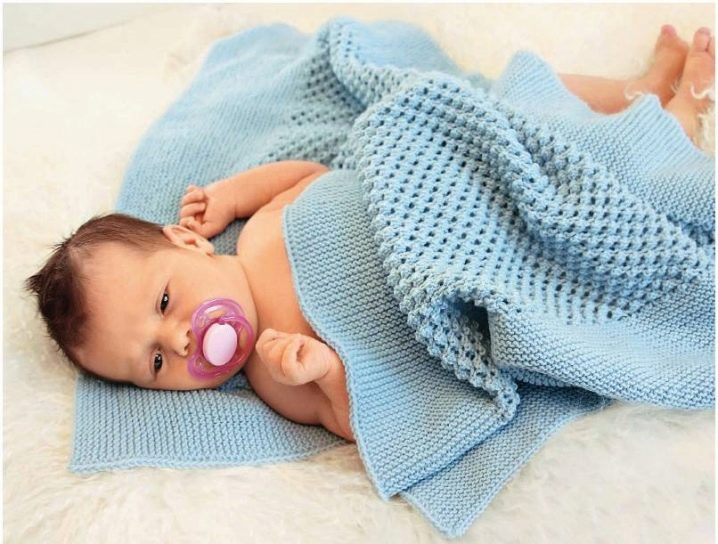
Features and Benefits
Knitted baby blankets are unique creations. They are intended for children, decorate the sleeping area and give it a neat, exclusive look. In addition to the aesthetic burden, they are multifunctional.
Depending on the age of the child, such products can:
- protect the sleeping place from mechanical damage, children's creativity, spillage of liquid;
- be a soft and warm cocoon sweater, wrapping a child in an armchair or on a sofa while reading books, board games, doing lessons;
- serve as a kind of voluminous diaper, replacing the blanket when swaddling babies;
- to be the first developmental rug of the baby when he just learns to crawl;
- be a litter on the floor when the baby is learning to walk;
- replacing a small blanket in the summer or off-season.

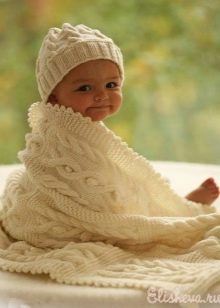
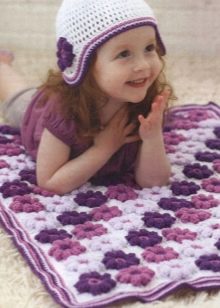
Such products are diverse and have a lot of advantages. They:
- are made from yarn of natural, artificial origin or their mix;
- are intended for children of different ages (from newborns to adolescents) and gender (for girls and boys);
- differ in the variability of the size range, allowing you to choose or make your own product to the existing furniture, taking into account its dimensions;
- have a large selection of color schemes, which is convenient and contributes to the successful combination of such products with existing furniture and other interior details;
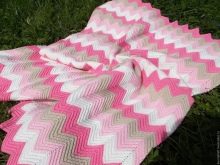
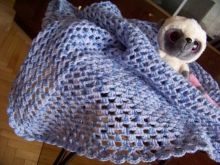
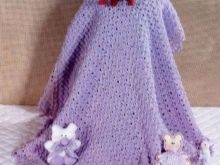
- are bright accents of a child's room or a connecting link of style items, can indicate a design idea or be customized for a specific object of the room;
- depending on the selected pattern, they can bring a sense of light and spaciousness into the space;
- performed for newborns and toddlers, they do not need a color combination with interior items;
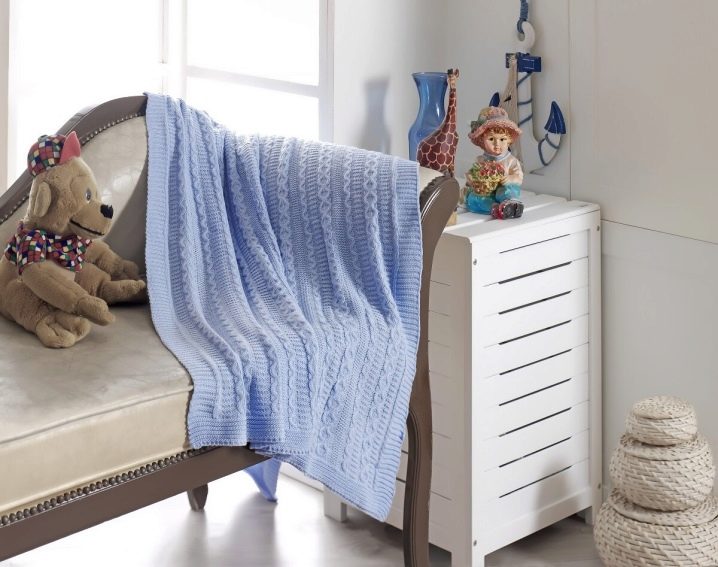
- to a large extent they are made using a hook or knitting needles, although there is a line of "machine" analogues, as well as a mixed technique, in which both a hook and knitting needles are used;
- are made of material of different textures, which allows you to create products with an openwork, modest pattern or large relief;
- they do not always need a large amount of raw materials for manufacturing;
- depending on the type of knitting, the amount of yarn and the size of the fabric, they differ in different total cost of the input raw materials.
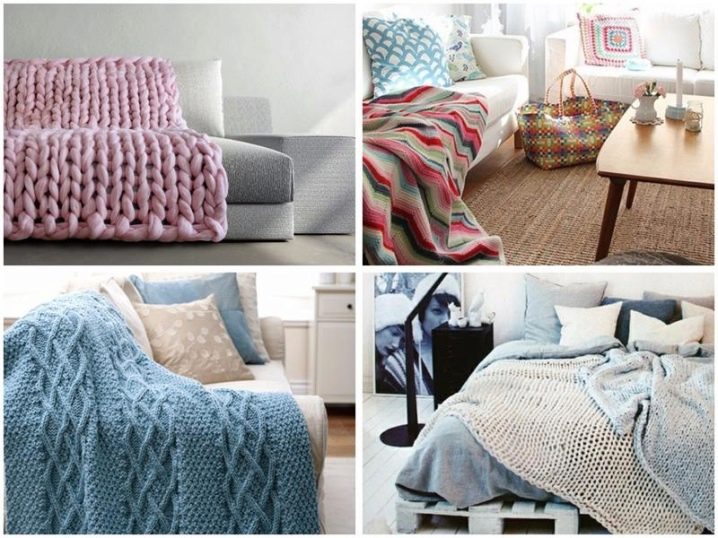
In addition to the main material, different decor is used in the production of knitted blankets for children. Most often these are pom-poms, multi-colored fringes, tassels, knitted lace. Models for school-age children can be decorated more progressively: beads are inserted into the loops, forming a certain pattern. However, such a technique is rare, because the main purpose of the blanket is to give warmth and comfort.
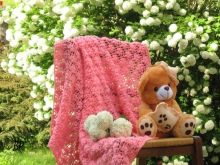

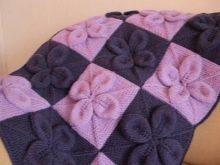
Unfortunately, with a lot of advantages, knitted baby blankets take a lot of time to make. This process is quite laborious and requires not only accuracy and perseverance: the execution of loops and patterns must be uniform, otherwise this drawback will affect the appearance of the finished product.
Other disadvantages of knitted blankets for children include their weight.If a small canvas can still be equated with textile counterparts, products for school-age children are not so much bulky as heavy. Not always, but this can cause discomfort, provoking the child to refuse such a thing as a blanket.


Therefore, before making any children's blanket, you need to consciously approach the choice of yarn: it should be light and voluminous (for example, grass).
In addition to weight, blankets have such a property as elasticity. This is good for a sweater, but it is not always convenient for filling a bed or sofa, because you need to fill it without distortions in the pattern of the canvas, folds and jams.
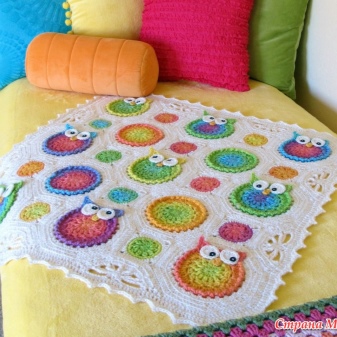
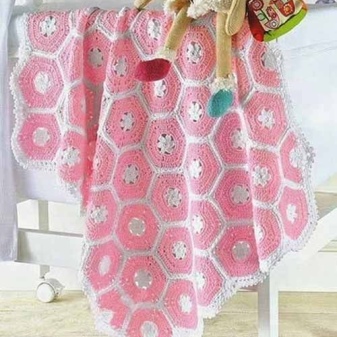
By design type, knitted baby blankets can be:
- classic plan, standard rectangular or square shape;
- non-standard shape (in the form of a circle, oval, rhombus, obeying the dimensions of the bed);
- a transformer model that combines the function of a blanket and a rug that develops motor skills.

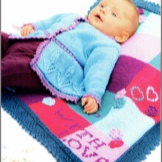
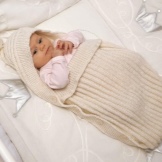
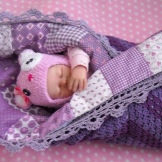
The first products are more traditional, they can have a longitudinal or transverse pattern (depending on how they are knitted), they can be performed row by row, forming a solid canvas or from separate fragments (squares) of identical sizes, connected with a hook or needle with thread. Non-standard models can differ in viscous in a circle or diagonally, starting the pattern from the corner.
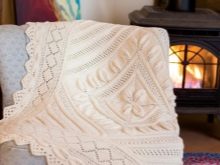
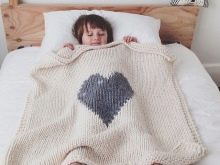
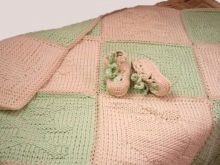
Materials and color
The yarn for knitting baby blankets is varied. However, with a wealth of choice for such products, light and, if possible, thin threads with a hollow fiber structure and a large distance between them are used: limbage, grass, cotton, cashmere, wool, semi-woolen threads, acrylic, polyamide, velsoft are suitable. You can knit a blanket from the special yarn of the Limbažu factory. These threads are economical and special: models knitted from limbage become bulky after washing.
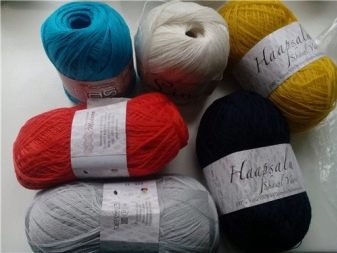
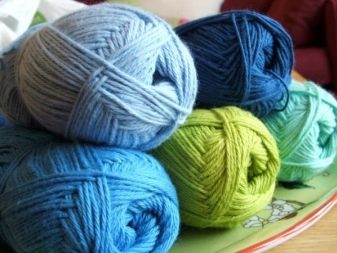
Choosing threads in the store, you can pay attention to the note "Children's": such yarn is distinguished by its soft texture, it practically does not prick and has a varied texture.
This is the usual twisted thread, and fiber with thickenings, pile, thread-braid with pom-poms and other types. In addition, the label always indicates the footage and the number of knitting needles: this is useful for creating a blanket and simplifies the selection of materials.
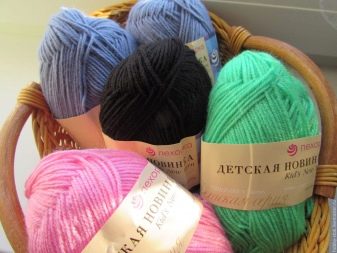
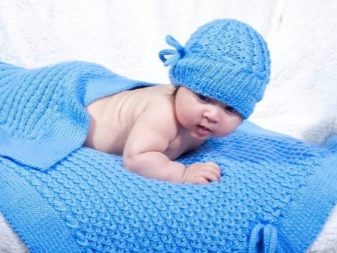
What should you pay attention to?
When making a blanket for a child, it is worth taking note of a few tips:
- too bulky product is not always convenient for babies (you should not sculpt animals and toys that make it heavier);
- do not overload the blanket with an abundance of patterns and decoration: this is ugly, deprives the product of beauty and a sense of style;
- embroidery on a knitted fabric flattens the texture of the material;
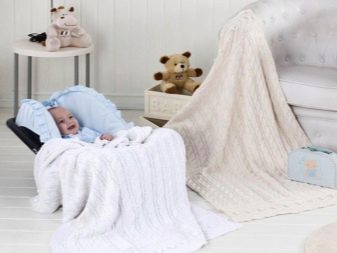
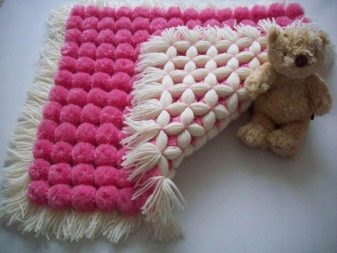
- do not decorate the blanket around the edges with a thin thread for knitting napkins: the pattern will not be visible if it is not starch;
- it is preferable to choose a symmetrical drawing of the model: this way it will look harmonious and complete;
- a pattern of residues of yarns of different texture can violate the integrity of the texture of the canvas, which will affect the appearance of the blanket;
- a small contrasting pattern provokes the appearance of ripples in the eyes: this will become an annoying factor and can cause a negative attitude towards the product.

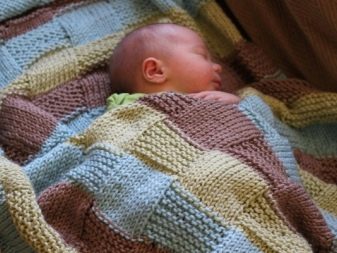
To turn a thin fabric into a full-fledged blanket, you can make a textile lining (for example, from fleece). When combined with the fabric, the blanket becomes warmer and can be used as a full-fledged blanket.
However, it is worth remembering: textiles should be bi-elastic and pleasant to the body, not accumulating static electricity.

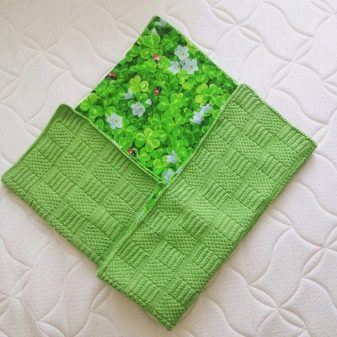
Dimensions (edit)
The parameters of the blanket can be any, however, it is worth starting from the age and height of the child:
- for a baby they knit a blanket 100x100 or 80x100, 70x125 cm (suitable for a stroller or cradle);
- to shelter children, it is better to knit rectangular models 100x140, 110x140 cm (they are more convenient) by measuring the length and width of the available blanket;
- the length and width of the model should cover the surface of the berth;
- the product is knitted with a margin for growth, since children grow very quickly, and it will take a lot of time to create.
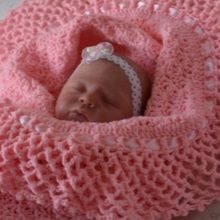
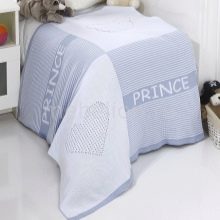
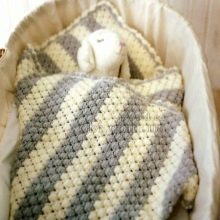
Knitting techniques and patterns
Perhaps only experienced craftswomen know the number of techniques that can be used to knit a blanket for a child. For a masterful hike, absolutely any pattern can be suitable for a children's knitted blanket (sirloin knitting, garter knitting, Scandinavian ornament, Bavarian technique, Tunisian knitting).
There are a lot of knitting styles. Each of them brings something special and unique to the design. This can be used to make the product not only the highlight of the room, but also in harmony with the overall design idea.
Styles are good motives for knitting a baby blanket:
- boho - slight negligence, while comfort and freedom, performed exclusively from natural materials (wool, cotton), since the style does not accept synthetics;
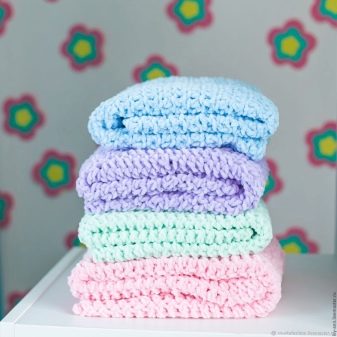
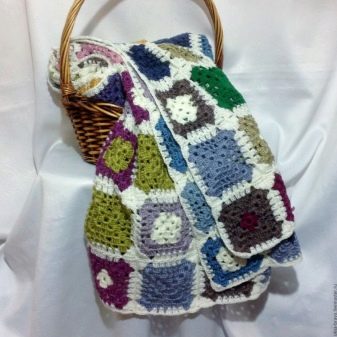
- missoni - contrasting horizontal zigzags of both a simple pattern and with the addition of lace motifs;
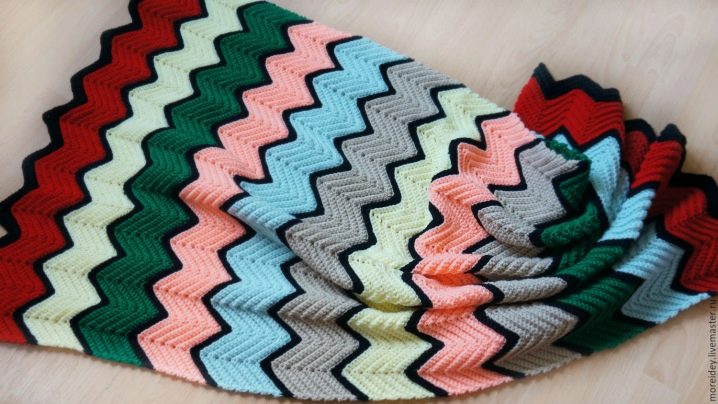
- broomstick - Peruvian knitting with crossed loops, crocheted or with a thick knitting needle, a smooth stick, an ordinal technique of plain or color-changing yarn, forming an openwork pattern;
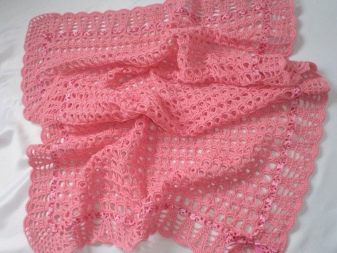
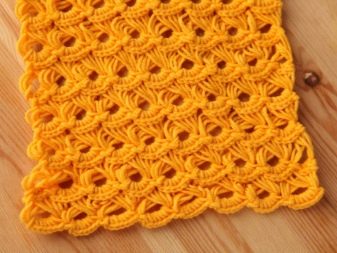
- swing - “partial knitting”, shortened rows, waves, variegated colors, done using markers in the form of pins (a great way to use the leftover yarn).
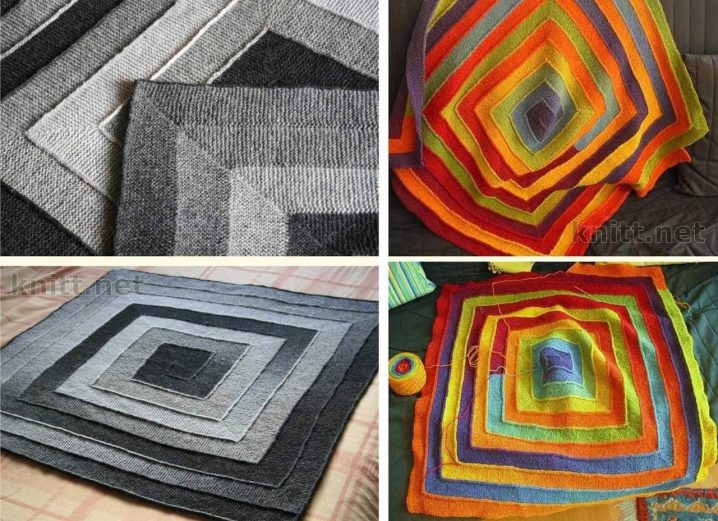
Ideas
A knitted blanket for children is a great opportunity to show skill and imagination. You can decorate the canvas with texture, openwork pattern or volumetric elements.
An interesting way to decorate is to create a pattern with colored threads.
The theme can be very different: these are all kinds of beautiful motives with hearts, bears, characters of children's cartoons or fairy tales, flowers, lambs, a bunny. The pattern can be created in different ways (in order or from separate squares with knitting of a certain motive

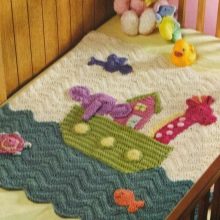
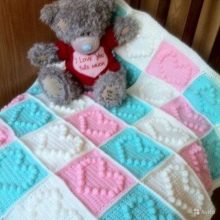
A single drawing also looks beautiful. Usually the canvas remains rectangular, but the main area is occupied by a large drawing in the form of a toy ("bunny" blanket). Those who like to work with one yarn choose threads with a color change: these blankets look very delicate. However, it is worth considering: braids, plaits, crossing loops reduce the width of the canvas. Therefore, before work, it is necessary to calculate the loops and tie the sample.
It is important to consider: creative models made of very large threads, forming braids 20 cm wide, are unacceptable for children, they are very heavy, and they look out of place.
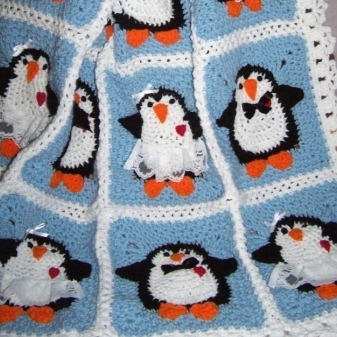
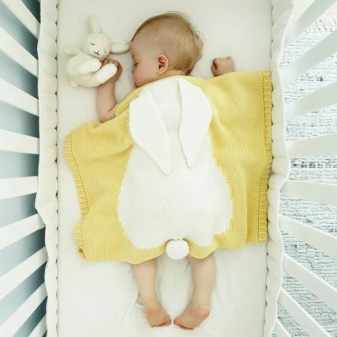
For information on how to knit a blanket for a child, see the next video













Thank you for the useful and interesting article!
The comment was sent successfully.